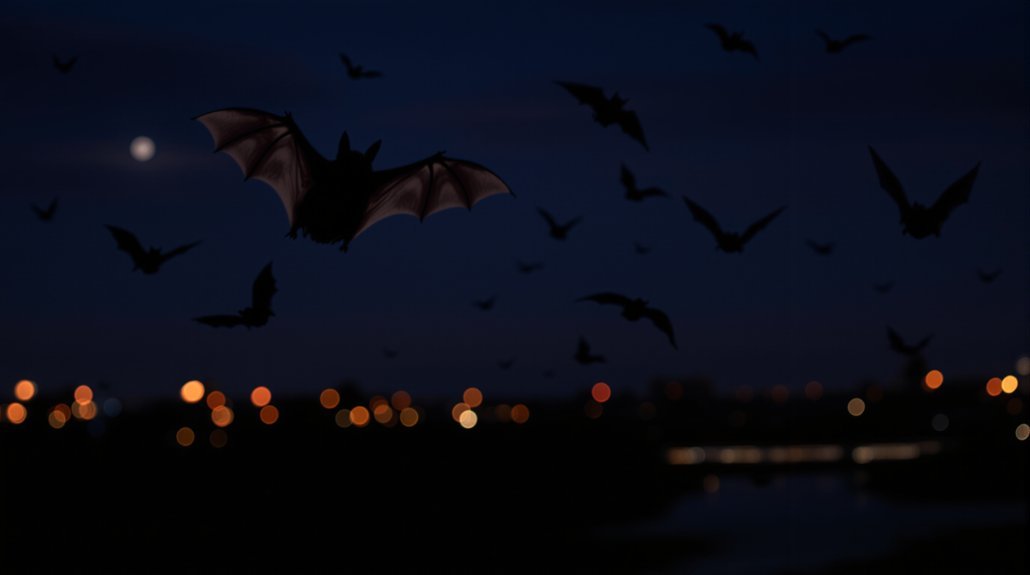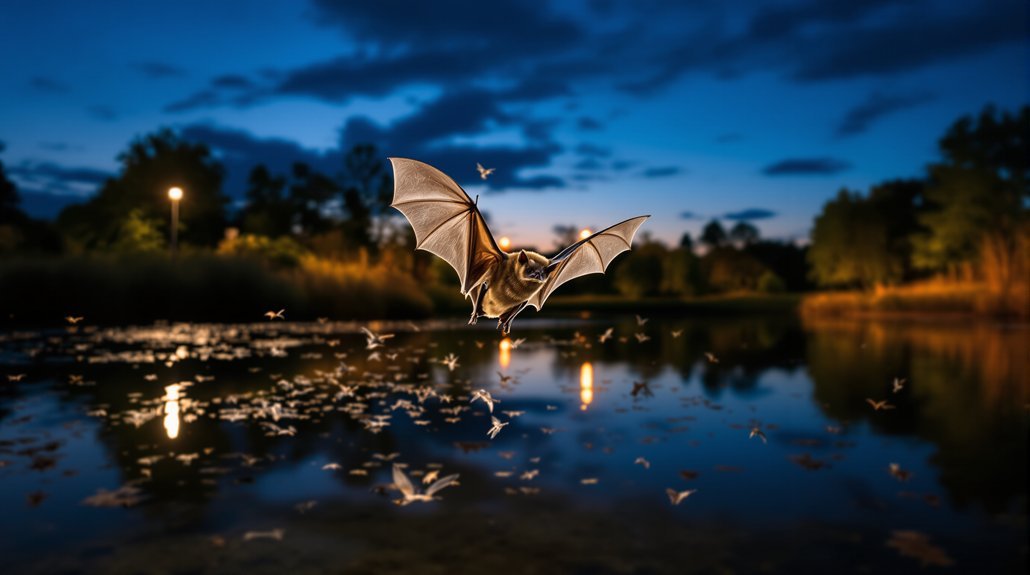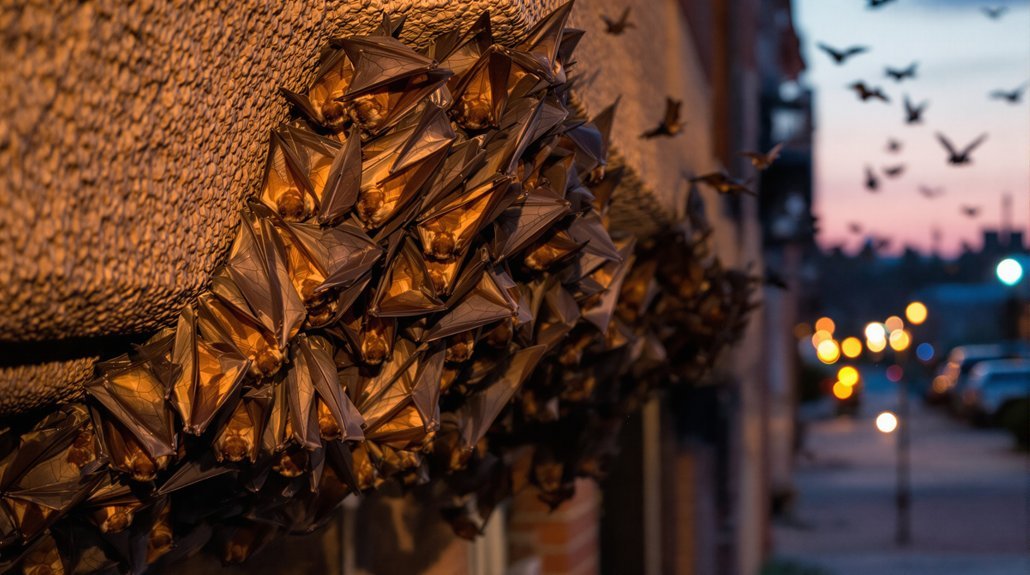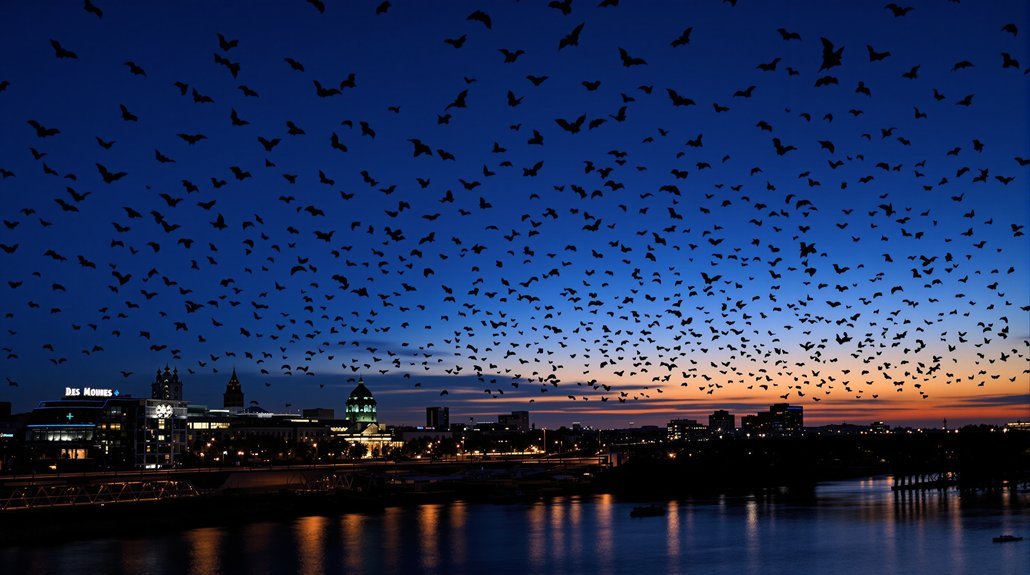Des Moines, Iowa, is home to several bat species. The most common include the Little Brown Bat, known for roosting in buildings, and the Big Brown Bat, which migrates seasonally. Other species include the Eastern Red Bat, Hoary Bat, Silver-Haired Bat, and Evening Bat. These bats play an important role in controlling insect populations and supporting the ecosystem. More information reveals their unique characteristics and behaviors, further explaining their significance in local environments.
Key Article Highlights
- Des Moines is home to several bat species, including the Little Brown Bat, Big Brown Bat, Eastern Red Bat, Hoary Bat, and Silver-Haired Bat.
- The Little Brown Bat roosts in buildings and trees, primarily feeding on moths, beetles, and flies.
- The Big Brown Bat, known for its large ears, plays a crucial role in controlling insect populations and migrates seasonally.
- The Eastern Red Bat has reddish-brown fur and roosts in trees, while the Hoary Bat prefers forested and open areas.
- The Silver-Haired Bat follows migratory routes and roosts in trees, contributing to pest control and ecosystem health.
Overview of Bats in Des Moines

Although many people might associate bats with darkness and mystery, in Des Moines, Iowa, these creatures play a crucial role in the local ecosystem. Bats contribute significantly to insect control, helping maintain balance in nature. Various species inhabit the area, each with unique characteristics and behaviors. Conservation efforts in Des Moines focus on protecting bat habitats and addressing threats like habitat loss and disease. Understanding migration patterns is vital for these efforts, as some bats travel long distances during seasonal changes. By studying these patterns, local organizations can create effective strategies to support bat populations. Recognizing bat habitat needs and implementing protection measures are essential for their continued presence. Additionally, understanding their timing and behavior is key to effectively managing human-bat interactions and supporting conservation initiatives. Through education and awareness, the community can engage in practices that promote the health of these essential animals, ensuring they continue to thrive in the environment.
Little Brown Bat

The Little Brown Bat is common in Des Moines and has specific habitat preferences. It often roosts in buildings and trees, seeking sheltered areas. This bat primarily feeds on insects, making it an important part of the local ecosystem.
Habitat Preferences
Little brown bats prefer a variety of habitats that provide both shelter and food sources. They often seek out roosting sites in buildings, trees, and bridges. These areas offer protection during bat migration and serve as ideal locations for raising their young.
| Habitat Type | Shelter Availability | Food Sources |
|---|---|---|
| Urban Areas | High | Insects near lights |
| Forested Areas | Moderate | Insects in foliage |
| Agricultural Land | Low | Insects near crops |
Understanding these habitat preferences helps in the preservation of little brown bats. Protecting their roosting sites is essential to ensure their survival in changing environments.
Diet and Feeding Habits
What do little brown bats eat to sustain their energy? These bats primarily consume insects, particularly moths, beetles, and flies. Their diet helps them meet their roosting requirements, as they need enough energy to thrive. Little brown bats exhibit dietary variations depending on the season and availability of food sources. During warmer months, they hunt in the evening, using echolocation to detect prey. Their feeding habits are vital for controlling insect populations, benefiting the ecosystem. In winter, they enter a state of torpor, which reduces their energy needs, but during active seasons, they require a steady supply of insects. Understanding their diet is essential for conservation efforts and maintaining healthy bat populations in Des Moines, Iowa.
Big Brown Bat

A common resident of Des Moines, the Big Brown Bat is known for its robust size and distinctive features. These bats can be identified by their large ears and broad wings. They are active at night, making them nocturnal creatures. During the warmer months, Big Brown Bats often hunt for insects, using echolocation to navigate. As the seasons change, they engage in bat migration, seeking warmer climates for survival. They typically roost in buildings, trees, or caves, providing them protection from predators. Big Brown Bats play an essential role in controlling insect populations. Their presence in urban areas contributes to ecological balance, showcasing the importance of these bats in the local environment.
Eastern Red Bat
The Eastern Red Bat is another fascinating species found in Des Moines, Iowa. This bat is known for its striking reddish-brown fur and is often seen roosting in trees. Despite common myths about bats being dangerous, the Eastern Red Bat is harmless to humans. It primarily feeds on insects, helping with natural pest control, which is essential for bat conservation efforts. Understanding these creatures is crucial for dispelling misconceptions and promoting their protection. The Eastern Red Bat plays an important role in the local ecosystem. By supporting bat conservation initiatives, the community can ensure that this unique species continues to thrive in Des Moines. Awareness and education are key to safeguarding these bats for future generations.
Hoary Bat
Known for its distinctive fur, the Hoary Bat stands out among the bat species in Des Moines, Iowa. This bat is easily recognized by its frosted appearance, which gives it a unique look. Hoary Bats are known for their long migrations, traveling great distances between summer and winter habitats. During migration, they often seek out forests and open areas for foraging.
Bat conservation efforts are essential for protecting the Hoary Bat and its habitat. These efforts aim to preserve natural environments and reduce threats such as habitat loss and climate change. Understanding the behaviors and needs of the Hoary Bat can help enhance conservation strategies. Protecting this species is vital for maintaining the ecological balance in the region.
Silver-Haired Bat
Silver-Haired Bats are an intriguing species found in Des Moines, Iowa. These bats exhibit unique traits that make them stand out among local wildlife.
- They have distinctive silver-gray fur, giving them their name.
- Silver-Haired Bats are known for their long migratory journeys, following specific bat migration patterns.
- They typically roost in trees, seeking shelter during the day.
- These bats play a crucial role in ecosystems, and understanding their habits is essential for bat conservation efforts.
Proper conservation measures can help protect their habitats and ensure their survival. By raising awareness about Silver-Haired Bats, communities can contribute to the efforts aimed at preserving this remarkable species in Des Moines and beyond.
Evening Bat
The Evening Bat is a small species known for its dark brown fur and distinctive face. It typically roosts in trees and buildings, making its home in urban and rural areas. This bat is active during the evening, hunting for insects in the twilight hours.
Physical Characteristics
Evening bats are medium-sized mammals characterized by their dark brown fur and wingspan of about 10 to 12 inches. These bats display several notable bat physical features that aid their survival and hunting methods.
- Their fur is soft and thick, providing insulation.
- They have large ears that are essential for echolocation techniques.
- Their wings are long and pointed, allowing for agile flight.
- Evening bats possess a small, rounded nose, enhancing their sense of smell.
These characteristics help evening bats navigate and locate prey in the dark. Their ability to use echolocation techniques makes them effective hunters, capturing insects during twilight hours. Overall, the combination of these physical traits contributes to their adaptability in various environments.
Habitat and Behavior
While they are often found in wooded areas, evening bats also adapt to urban environments, roosting in trees, under bridges, and in buildings. These bats are nocturnal, becoming active at dusk to hunt for food. Their diet mainly consists of moths, making them essential for moth pollination. By feeding on these insects, evening bats provide valuable pest control, helping to maintain a balanced ecosystem. They typically forage in open areas, using echolocation to locate their prey. Evening bats often gather in large groups during the summer months, which aids in social interaction and reproduction. Their adaptability to various habitats allows them to thrive in both rural and urban settings, showcasing their resilience as a species.
Importance of Bats to the Ecosystem
Bats play a crucial role in maintaining a healthy ecosystem. They provide essential ecosystem services that benefit both nature and humans. Understanding their importance emphasizes the need for bat conservation.
- Pest control: Bats consume large amounts of insects, reducing the need for chemical pesticides.
- Pollination: Some bat species help pollinate plants, supporting biodiversity and food production.
- Seed dispersal: Bats aid in spreading seeds, promoting plant growth and forest regeneration.
- Nutrient cycling: Bat guano enriches soil, enhancing its fertility for plants.

